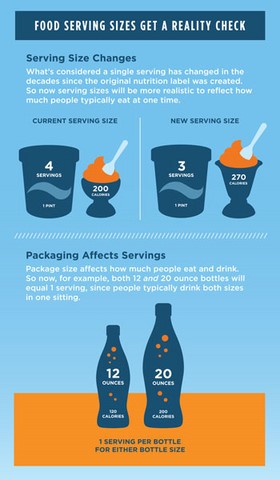2020 FDA Food Labels Are Becoming a Bit Clearer

Have you ever wondered how much added sugar goes into the food you consume? Well, there is no need for guessing. The U.S. Food and Drug Administration (FDA) is giving food labels a much-needed update in 2020.
If you are a calorie cruncher, then you have probably noticed the Nutrition Facts label changes on the back of packaged foods, in addition to restaurant menus and vending machine food products.
The FDA completed its final rules on food labels May 27, 2016. Now, manufacturers with $10 million or more in annual food sales are required to use the new labels by January 1, 2020. Other manufacturers with less than $10 million in annual sales, must modify their labels by January 1 of next year. Food producers of products such as honey, maple syrup, and specific cranberry goods have until July 1, 2021 to comply.
New Look
One of the changes made to the label is its noticeable calories and serving size. Both have been bolded to gain accessibility, while the calories per serving number took a more enlarged font size. According to the FDA, this user-friendly look will “ensure consumers have access to the information they need to make informed decisions about the foods they eat.”
Serving Size Changes
The serving size changes now reflect the amount of food Americans today are consuming. This amount has increased from over 20 years ago.
Currently, if a food product’s serving size is a bit more than one serving, labels must reference one serving size because people usually consume it all, instantly, such as a 20 oz. bottle of soda or a 15 oz. can of soup.
Larger products where the serving size is more than one serving but can be consumed in one or more sittings must have two label columns showing the number of calories and nutrients per serving and per package, such as a pint of ice cream.
Changes in Daily Value% and Nutrition
Other changes made are the updated daily value percentages and nutrition information. The FDA requires that manufacturers include Vitamin D and potassium on food labels for reasons associated with chronic disease, which is caused by a deficiency of these nutrients.
Indications of Vitamin A and C are optional
Since reports show that the American daily diet is sometimes lacking in Vitamin D and potassium, the nutrients have become significant. While, on the other hand, not many U.S. consumers have a deficiency in Vitamin A nor C. Therefore, the indications of these vitamins have become optional.
“Added sugars” is also a new daily value that is required to ensure you have more information to make better decisions. It will help shine a light on additional sugars manufacturers use in their food products.
The inclusion of ‘added sugars’ in the Nutrition Facts label are causing food producers to reformulate their ingredients to reduce sugar levels. In a Chemical & Engineering News (C&EN) article written by Melody M. Bomgardner, suggests that food producers are likely to adjust their recipes overtime in an effort to reduce sugar levels to meet societal norms, which in return will open doors for more natural sweeteners, such as stevia.

Stevia Plant
So, if you are looking to lessen the amount of sugar you eat, be more diligent in the types of comfort foods you like to indulge in. The recommended limit of added sugars intake is 10 percent or less of calories.
"Calories from Fat" are removed
If you notice, Vitamin A and C are not the only things missing from the new label design. The FDA has decided to do away with “Calories from Fat.” The Administration found that it’s the type of fat that matters most rather than the amount.
Finally, a new improved footnote that simplifies the definition of the percent daily value.
If you are wondering if foods imported to the U.S. must go through the same labeling requirements the answer is yes.
Why Changes?
Douglas Balentine, Ph.D., the director of FDA’s Office of Nutrition and Food Labeling, stated, “We hope that updating the label in these ways makes it easier for people to be more realistic about the number of calories and nutrients they’re actually consuming and to make healthier choices when choosing foods for themselves and their families.”
Because more recent information about nutrition and health is being published, the FDA decided that it was time to retire the old label requirements that has been around for over two decades and introduce a new standard for labeling to meet the health sciences of today.
Maybe now we can be more mindful of what we eat.
Did you find this article helpful? Feel free to like us on Facebook.



